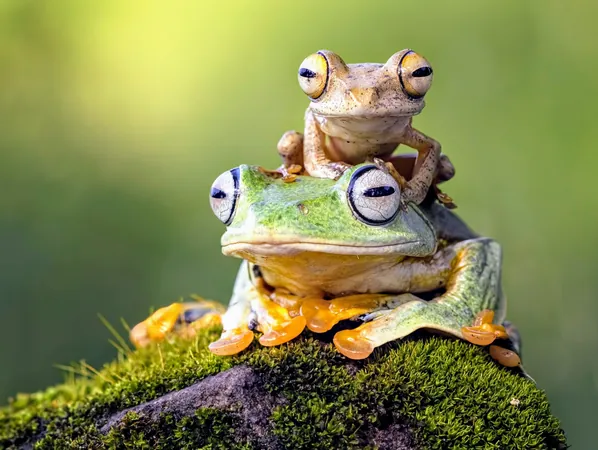
Frogs May Hold the Secret to the Next Generation of Antibiotics
2025-03-26
Author: Sarah
Frogs May Hold the Secret to the Next Generation of Antibiotics
As antibiotic resistance continues to escalate, we've entered a perilous era where once-treatable infections can now spread unchecked. The answer to this impending crisis could very well arise not from sophisticated laboratories but from the swamps and forests that provide refuge to frogs. These remarkable amphibians, which have survived for over 200 million years, possess powerful natural defenses that may just be the key to developing the next generation of antibiotics.
Frogs are uniquely adapted to thrive in environments jam-packed with microbes, yet they suffer surprisingly few infections—a mystery that has captivated researchers for years. Are these ancient creatures hiding biological secrets that could save human lives? According to Professor Cesar de la Fuente and his team at the University of Pennsylvania, the answer is a resounding "yes."
Unleashing Nature: Frogs as Antibiotic Producers
Frogs are remarkable survivors, inhabiting diverse ecosystems from rainforests to arctic regions. Their unique evolutionary journey has pushed many species to develop antimicrobial peptides within their skin to combat the constant bacterial threats they face. These peptides offer an edge over traditional antibiotics, which often lead to resistance.
One striking example is the Odorrana andersonii, a frog species known for producing a potent peptide, referred to as Andersonnin-D1. While this peptide has shown promise in fighting bacteria, its tendency to clump poses challenges that prevent its direct application in medicine.
Crafting Synthetic Solutions
Guided by the need for innovative solutions, Professor de la Fuente's lab has embarked on a mission to rethink and redesign the antibiotic properties of Andersonnin-D1. Through the meticulous use of structure-guided design, researchers manipulate the chemical structure of the peptide to eliminate its toxicity while enhancing its antibacterial potency. This approach allows them to test various modifications and find the most effective compounds.
Recent lab tests have produced several synthetic peptides that retain strong antimicrobial efficacy without the clumping problem present in the original Andersonnin-D1. Remarkably, these synthetic alternatives performed on par with polymyxin B, a critical last-resort antibiotic, in preclinical models while exhibiting low toxicity levels, sparing human cells and preserving beneficial gut bacteria.
A Step Closer to Human Trials
If subsequent studies confirm their effectiveness, the team will move toward Investigational New Drug (IND) enabling studies, which are crucial for assessing safety and efficacy before these promising treatments can be considered for clinical trials on humans. "It’s incredibly exciting to think that frogs—and indeed nature as a whole—could contribute to developing new antibiotics," said de la Fuente.
This pioneering research showcases the potential of merging evolutionary biology with advanced engineering. Rather than designing entirely new molecules from scratch, scientists are revisiting tried-and-true natural solutions that evolution has perfected over millennia. This approach may unlock treatments that are not only more effective but also kinder to our bodies.
Why This Matters Now More Than Ever
The implications of this work could be transformative. As the global health community searches for new antibiotics amidst rising resistance, solutions may lie in nature's designs, where ancient biological defenses become the foundation for modern medicine. The groundbreaking study, recently published in the journal Trends in Biotechnology, highlights the importance of nature-driven innovation in the fight against antibiotic resistance.
In a world increasingly dominated by synthetic alternatives, it's refreshing to see a scientific movement that advocates for learning from nature's time-tested methods. Who would have thought that the swamp might hold our next major medical breakthrough? Keep following this story—nature may soon be revealing how these age-old amphibians are poised to save us in the fight against drug-resistant infections.



 Brasil (PT)
Brasil (PT)
 Canada (EN)
Canada (EN)
 Chile (ES)
Chile (ES)
 Česko (CS)
Česko (CS)
 대한민국 (KO)
대한민국 (KO)
 España (ES)
España (ES)
 France (FR)
France (FR)
 Hong Kong (EN)
Hong Kong (EN)
 Italia (IT)
Italia (IT)
 日本 (JA)
日本 (JA)
 Magyarország (HU)
Magyarország (HU)
 Norge (NO)
Norge (NO)
 Polska (PL)
Polska (PL)
 Schweiz (DE)
Schweiz (DE)
 Singapore (EN)
Singapore (EN)
 Sverige (SV)
Sverige (SV)
 Suomi (FI)
Suomi (FI)
 Türkiye (TR)
Türkiye (TR)
 الإمارات العربية المتحدة (AR)
الإمارات العربية المتحدة (AR)